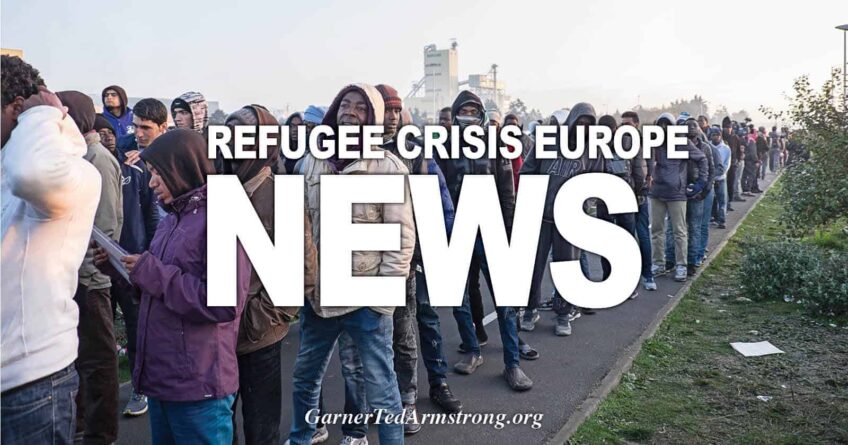
French President Emmanuel Macron’s government introduced a bill last week that would accelerate the expulsion of migrants who do not qualify for asylum and make illegal border crossings a criminal offense punishable by one year in jail and a fine.
And Hungary is considering a bill that would include entry bans on foreigners and restraining orders to stop Hungarians from going to border areas if they are deemed to be “supporting” or “organizing” illegal immigration.
It isn’t surprising that European countries are adopting harsh measures to deal with the wave of asylum-seeking migrants that began in 2015. They cannot secure their borders effectively.The European Union (EU) established the Schengen Agreement in 1985, which abolished the internal border checks of signatory countries. This provides free and unrestricted movement between countries in the Schengen Area for the more than 400 million nationals of the 26 signatory countries, and of goods, services, and capital, in harmony with common rules for controlling external borders.
However, there is a mandatory visa requirement to enter the Schengen Zone for some non-member countries.
Under schengen rules, signatories may reinstate internal border controls for 10 days when this has to be done immediately for “public policy or national security” reasons. If the need continues, the controls can be maintained for “renewable periods” of up to 20 days and for a maximum of two months.
The EU’s “open borders” policy permits European states to shunt migrants from one country to the next instead of having to deal with a mass influx into its own territory.
European countries do not have to provide care for migrants who are moving across Europe to reach countries they want to settle in.
For instance, Sudanese migrants are increasingly visible in Brussels near train stations, in public squares and parks, and sometimes sleeping in the streets. Very few of them plan to stay in Brussels.
Belgium’s Secretary for Asylum Policy and Migration, Theo Francken, says Belgium is not responsible for the care of migrants unless they apply for asylum.
Making the situation worse, pursuant to the EU’s Dublin II regulation, refugees are supposed to apply for asylum in the first EU country they reach, and EU nations are resisting any changes to this regulation that would cause them to receive more migrants.
This has created an impossible burden for Greece and Italy, which have become the main gateways for 1.5 million refugees arriving on Europe’s shores over the last three years.
The EU Commission sought to redistribute 160,000 asylum seekersthroughout the EU from Greece and Italy, but lack of cooperation from other EU nations made it impossible to achieve that goal. When the program ended, only 31,000 refugees had been resettled.
But fewer migrants are coming to Europe. Only 186,768 migrants came in 2017. The following chart provides an overview of arrivals that year.
The numbers have not gone down because fewer people need refuge.
European governments entered into partnership agreements with North African countries in 2017. They offered financial support to them in exchange for stepped-up border patrols and crackdowns on migrant smuggling in their territories.
While these agreements have succeeded in reducing the numbers, it has come at a human cost. In Libya, the launch point for most of the migrant journeys to Europe, migrants intercepted while fleeing from Libya are sent to detention centers. Government and NGO reports have documented widespread physical and sexual violence, more conditions and killings at these centers.
Crime.
In 2016, Germany accepted the largest population of asylum seekers in Europe, but it has not worked out well for Germany. According to a study conducted by the Zurich University of Applied Sciences, the German state of Lower Saxony has experienced a 10.4 percent increase in violent crime.
German criminologists claim that the best way to prevent violent crime among migrants is to provide them with better integration opportunities. It also could help if Germany allowed them to be reunited with their families. Germany recently limited family reunifications.
In view of Europe’s low natural population growth rate, refugee family reunification could be a great benefit by adding to the birth rate in the EU. In the first half of the 1960s, the population of the EU increased by only 0.8 percent a year, and the birth rate is even lower now.
The European economy, meanwhile, is growing, which is producing labor shortages. Europe needs population inflows from outside the EU to increase its workforce.
The EU needs to ensure that the Schengen Agreement does not prevent individual nations from securing their borders, and it should consider making a greater effort to integrate its migrant population.
Nolan Rappaport was detailed to the House Judiciary Committee as an executive branch immigration law expert for three years; he subsequently served as an immigration counsel for the Subcommittee on Immigration, Border Security and Claims for four years. Prior to working on the Judiciary Committee, he wrote decisions for the Board of Immigration Appeals for 20 years.
[Disclaimer]








